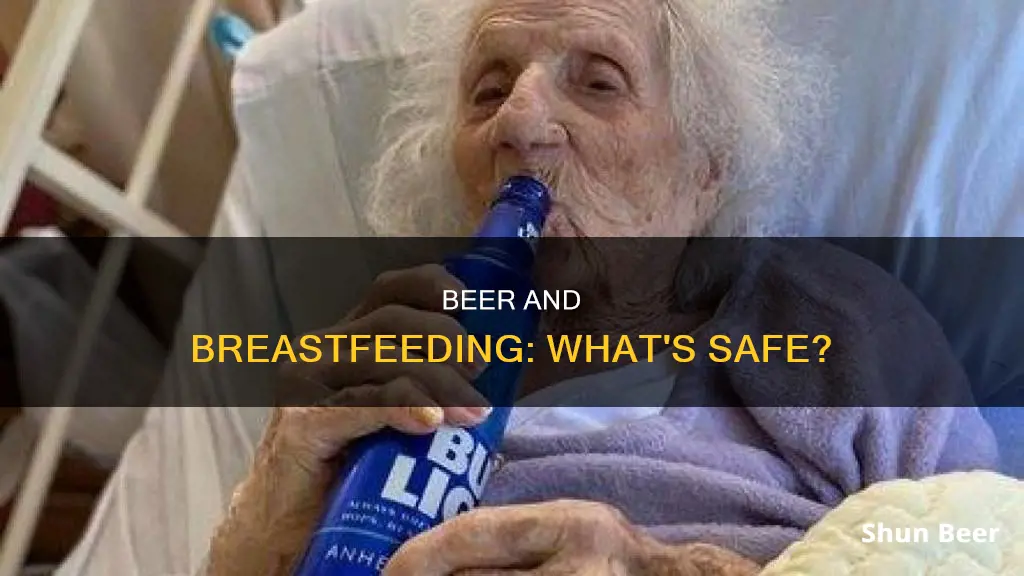
Nursing mothers are often faced with conflicting advice about alcohol consumption and its effects on their babies. While it is generally advised to abstain from alcohol during pregnancy, less information is available regarding alcohol consumption while breastfeeding. Studies have shown that alcohol can cause drowsiness, deep sleep, weakness, and abnormal weight gain in infants, as well as a decreased milk ejection reflex in mothers. However, consuming no more than one drink per day has not been found to have harmful effects on babies.
So, can you drink a beer and nurse? The answer is yes, but with important considerations and precautions. It is recommended to wait for at least two hours after drinking one standard drink before breastfeeding. This allows the alcohol to metabolize and leave the breast milk. Additionally, drinking on a full stomach and planning ahead by breastfeeding before consuming alcohol can help maximize the time between drinking and nursing. It is crucial to prioritize the safety of the baby and avoid drinking to the point of intoxication.
| Characteristics | Values |
|---|---|
| Is it safe to drink alcohol while breastfeeding? | Yes, but in moderation. |
| How much is safe to drink when breastfeeding? | One standard drink is usually considered safe, but it's important to be cautious. |
| How long after drinking alcohol can you breastfeed? | It is recommended to wait for at least two to three hours after a single drink before breastfeeding. |
| Does alcohol affect breast milk production? | Regular alcohol consumption can negatively affect breast milk supply and the let-down reflex. |
| Can babies get drunk from breastfeeding? | Babies won't get drunk, but regular exposure to alcohol through breast milk can have negative effects on their development, weight gain, and sleep patterns. |
| Should you "pump and dump" after drinking? | Pumping and dumping is not necessary as alcohol leaves the breast milk as it metabolizes from the bloodstream. However, it can be done for comfort if the breasts become engorged. |
What You'll Learn
- Drinking alcohol while breastfeeding is generally safe, but moderation is key
- Alcohol can stay in breast milk for 2-3 hours, with the highest levels occurring 30-60 minutes after drinking
- One drink doesn't always mean one glass. One standard drink is 12 oz. of 5% ABV beer
- Nursing mothers should wait until they feel “neurologically normal” before breastfeeding after drinking
- Pumping and dumping is not necessary, but it can provide relief for engorged breasts

Drinking alcohol while breastfeeding is generally safe, but moderation is key
Drinking alcohol while breastfeeding is generally considered safe, but moderation is key. While drinking alcohol, it is important to understand your body and drink responsibly. According to the Dietary Guidelines for Americans, it is recommended to wait for about two hours to breastfeed after finishing one drink. If you've had two drinks, wait for about four to five hours. It is advised to wait until your body has completely metabolized the alcohol before nursing your baby again.
The level of alcohol in your milk is similar to the amount in your blood. Once you've metabolized the alcohol, it's out of your breast milk, too. The alcohol concentration in your milk peaks about 30 to 60 minutes after drinking, and then it starts to drop. If you have a drink and a refill, there will still be very little alcohol in your milk and very little ingested by your baby.
However, drinking alcohol can negatively affect your milk supply. Alcohol interferes with the levels of prolactin, a hormone that helps produce milk. It can also delay the let-down reflex, which can result in the baby getting less milk.
It is best to plan ahead and wait a few hours after consuming alcohol to breastfeed. If you are unsure about how long you should wait, you can refer to the chart developed by Motherisk, which factors in body weight and the number of drinks consumed to determine how long it takes for alcohol to clear a woman's system, including her breast milk.
While drinking alcohol while breastfeeding is generally safe, it is important to be cautious and consume alcohol in moderation.
The Chemistry of Beer: How It Works and Why It Matters
You may want to see also

Alcohol can stay in breast milk for 2-3 hours, with the highest levels occurring 30-60 minutes after drinking
Alcohol can typically be detected in breast milk for about 2 to 3 hours after a single drink is consumed. However, the length of time alcohol can be detected in breast milk depends on how much alcohol a mother consumes. For example, alcohol from two drinks can be detected in breast milk for about 4 to 5 hours, and this increases to about 6 to 8 hours if she has three drinks.
The amount of alcohol in breast milk is influenced by several factors, including how fast it is consumed, whether it is consumed with food, the mother's body weight, and individual variations in alcohol absorption and metabolism.
Peak alcohol levels in breast milk occur 30 to 60 minutes after consuming an alcoholic beverage. During this time, the alcohol levels in breast milk are similar to those measured in the maternal blood.
It is important to note that even small to moderate amounts of alcohol may impair milk production and the milk ejection reflex. Research has shown that nursing infants consumed approximately 20% less milk in the first 4 hours after maternal alcohol consumption. Additionally, alcohol can cause adverse effects on the infant's sleep patterns, with studies showing more frequent but shorter sleep periods after consuming alcohol-laced milk.
To minimise the amount of alcohol in breast milk, it is recommended to breastfeed before consuming alcohol and to wait at least 2 hours after drinking before nursing again.
Beer Left Outside: Still Refreshing or a Disaster?
You may want to see also

One drink doesn't always mean one glass. One standard drink is 12 oz. of 5% ABV beer
It's important to know what counts as a standard drink, as the amount of liquid in your glass may not match up with the amount of alcohol in your drink. Different types of beer, wine, or malt liquor can have varying alcohol content. For example, many light beers have almost as much alcohol as regular beer, with around 85% of the alcohol content.
In the United States, one "standard" drink (or one alcoholic drink equivalent) contains roughly 14 grams of pure alcohol. This is the amount of alcohol typically found in 12 ounces of regular beer, which is usually about 5% alcohol (by volume or ABV). To put it another way, a standard drink contains 0.5 ounces of pure alcohol, and the body can metabolize about one standard drink per hour.
So, when people refer to "one drink", they are usually referring to a standard drink, which is 12 ounces of regular beer with 5% ABV. However, it's important to note that craft beers can have a higher ABV, with some containing as much as 12% ABV or more. In these cases, one 12-ounce bottle of craft beer would count as multiple standard drinks.
The ABV will tell you how many ounces of actual alcohol are in the beverage. For example, if a 12-ounce bottle of beer has 5.0% ABV, that means the bottle contains 0.6 ounces of pure alcohol. This can be calculated using the following equation:
Ounces x decimal percentage of alcohol = ounces of alcohol in the bottle or drink
For example: 12 (ounces) x 0.05 (5%) = 0.6 ounces
Plato's Beer: The Science Behind It
You may want to see also

Nursing mothers should wait until they feel “neurologically normal” before breastfeeding after drinking
The recommended limit for alcohol consumption is 14 units a week. A unit is roughly equivalent to a single drink. To keep health risks from alcohol to a low level, it is best not to drink more than 14 units a week on a regular basis. If a mother does drink 14 units a week, it is best to spread the drinking evenly over three or more days.
If a mother intends to have a social drink, it is recommended to avoid breastfeeding for 2 to 3 hours for every drink consumed to avoid exposing the baby to any alcohol in the milk. This allows time for the alcohol to leave the breast milk. Mothers may want to plan ahead by expressing some milk before a social function. They can then skip the first breastfeed after the function and feed the baby with the expressed milk instead.
It is important to note that the more a mother drinks, the longer it takes for the alcohol to clear their system. Binge drinking, or consuming more than 6 units of alcohol in one session, may make a mother less aware of her baby's needs. If a mother is planning on binge drinking, the baby should be cared for by an adult who has not consumed any alcohol.
Working for Beer Distributors: What You Need to Know
You may want to see also

Pumping and dumping is not necessary, but it can provide relief for engorged breasts
Pumping and dumping is not necessary if you are a casual drinker, having a glass of alcohol one or two times a week. Alcohol leaves the breast milk when it leaves the bloodstream, so it will eventually leave your system naturally. However, if you are experiencing discomfort due to engorgement, pumping and dumping can provide relief.
Pumping and dumping is a technique where you express breast milk and then discard it instead of storing it for your baby to consume later. It is often done by mothers who think they have had too much to drink. While it does not get rid of alcohol in your system, it can help prevent engorgement and mastitis, a painful inflammation of the breast, from developing.
If you are drinking alcohol, it is recommended to wait at least two hours before breastfeeding your baby to ensure the alcohol has cleared your system. Alcohol can inhibit the let-down reflex, reducing the amount of milk released and consumed by the baby. It can also change the taste of your milk, making it less desirable to your baby.
If you are experiencing engorgement while waiting for the alcohol to leave your system, pumping and dumping can provide relief. However, it is not necessary for casual drinkers, and alcohol will naturally leave your breast milk as it leaves your bloodstream.
Beer After a Workout: Good or Bad Idea?
You may want to see also
Frequently asked questions
Yes, it is safe to have an occasional drink while breastfeeding. However, it is important to wait until the alcohol has left your breast milk before nursing your baby. The time it takes for alcohol to leave your breast milk depends on various factors, including the number of drinks consumed, body weight, and individual metabolism. Generally, it is recommended to wait for at least two hours after a single drink before breastfeeding again.
Alcohol can interfere with the let-down reflex or milk ejection reflex, resulting in a decreased milk supply. It can also affect the taste of breast milk, which may be unappealing to the infant. Additionally, alcohol passes into breast milk, and the concentration of alcohol in the milk is similar to that in the mother's bloodstream.
Drinking alcohol while breastfeeding can negatively impact an infant's growth, motor function, and sleep patterns. It may also lead to developmental delays, such as reduced motor control, and increased agitation. In some cases, infants may consume less milk and have trouble gaining weight.
Alcohol impairs judgment and can compromise the safety of the infant. It can also affect the mother's ability to care for the child and increase the time it takes to push out milk. Additionally, regular alcohol consumption can lead to a lower milk supply and delayed let-down reflex.







